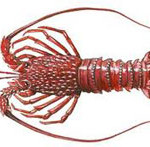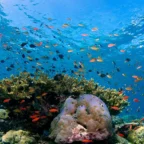
Diplodus sargus capensis
Seabream or porgies are members of the Sparidae family of carnivorous bony fishes. Porgies are carnivores of hard-shelled benthic (bottom dwelling) invertebrates. Many species have been found to be hermaphroditic; some have male and female gonads simultaneously. Others change gender as they get larger.
The structure of the fins of Porgies is essentially the same as in the family Serranidae of seabasses with which they can be confused. There are important anatomical differences, however, most obvious of which are that the edge of the gill cover does not end with a sharp spine in the porgies but is rounded or at most bluntly angular; and that the maxillary bone (the bone forming the margin of the upper jaw) is sheathed and hidden when the mouth is closed.
Long, pointed pectoral fins (found on each side of the body behind the gill opening) are likewise characteristic of the family; the spiny and soft portions of the dorsal (back) fin are continuous, and the soft-rayed anal fin is about as long as the soft part of the dorsal. There are over fifty different species of porgies to be found in the southeastern Atlantic, but we would you to survey and record just one particular species, the Cape white seabream (Diplodus sargus capensis), also known as a blacktail or dassie.
The Cape white seabream is primarily an inshore species, favouring turbulent seas and rocky shores, but also often occurs in small shoals over the outer edges of deeper reefs and around offshore pinnacles, to depths of 50m. The diet of this fish changes with age, and as the fish grows so does its intestine, enabling it to change from a short gutted carnivore, to becoming a more omnivorous adult, able to digest large amounts of plant material, giving the adults a wide range of feeding options including red and green seaweeds to mussels and sponges.
The oval-shaped body with its pointed snout is predominantly silver and there is an unmistakable black saddle that occurs on the caudal peduncle (just between the dorsal and tail fins). The tail fins themselves are, unsurprisingly, black. The maximum adult size is 45cm, but most fish that you see will be smaller than this.
Note: Many species of fish and plants are known by different names in different locations. Where appropriate, we provide the recognised scientific name, but in the case of common names, for the sake of consistency, we have used the common names as they appear in the fishbase.org database.









Social Profiles